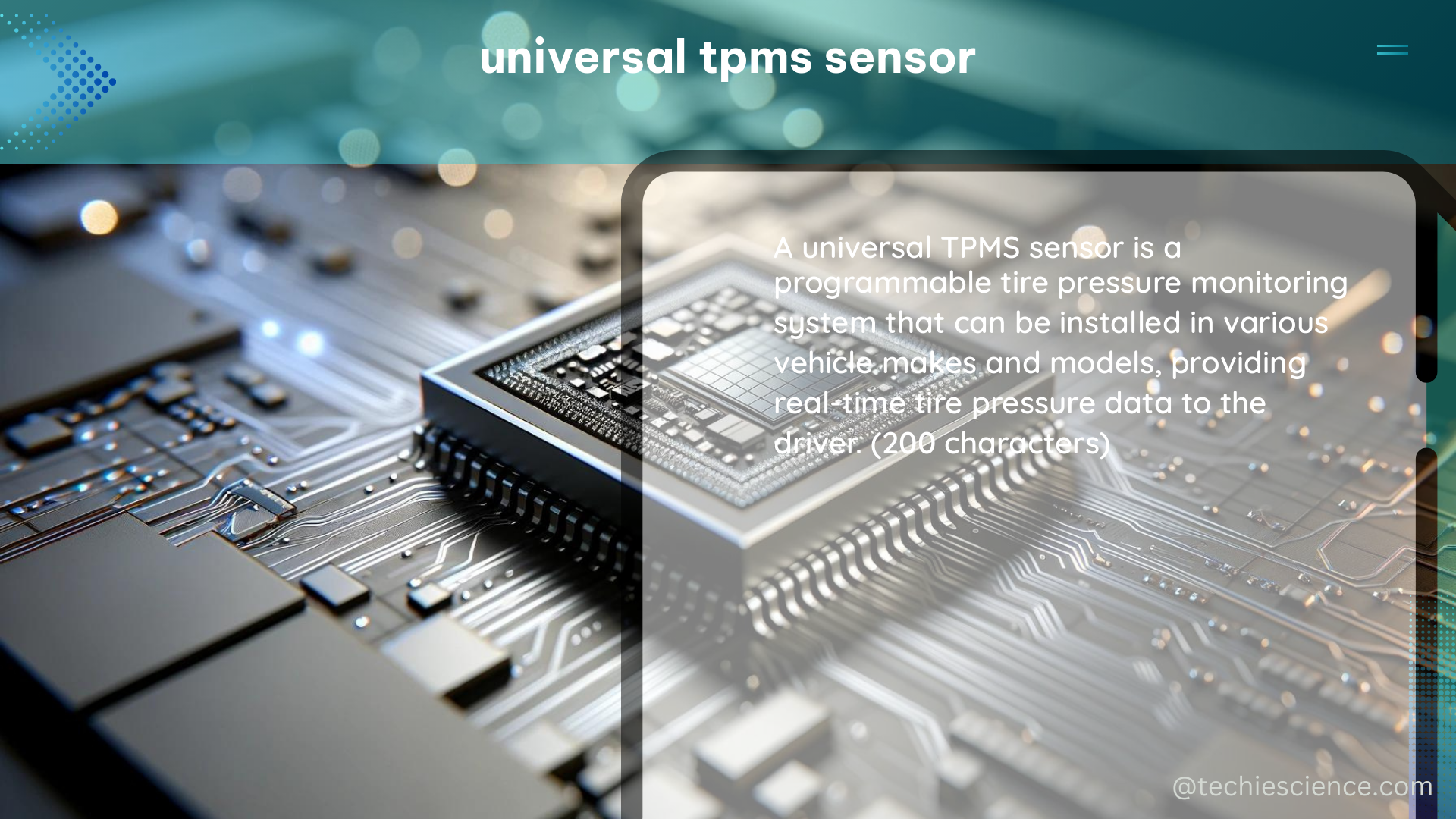Universal TPMS (Tire Pressure Monitoring System) sensors are versatile devices that can be programmed to work with a wide range of vehicle makes and models. These sensors operate on either 315MHz or 433MHz frequency bands, and a specific signal on these bands can put the sensor into pairing mode when held close to the valve stem. With their ability to emulate OE sensors, universal TPMS sensors offer a cost-effective solution for monitoring tire pressure, making them a popular choice among DIY enthusiasts and automotive professionals alike.
Understanding the Frequency Spectrum
At the heart of universal TPMS sensors are the frequency bands they operate on. These sensors can be divided into two main categories based on their operating frequency:
- 315MHz TPMS Sensors: These sensors are commonly used in North American and Asian markets, where the 315MHz frequency band is the standard for TPMS applications.
- 433MHz TPMS Sensors: These sensors are more prevalent in European and other international markets, where the 433MHz frequency band is the preferred choice for TPMS systems.
It’s important to note that the specific frequency used by a universal TPMS sensor can have a significant impact on its compatibility with a given vehicle. Ensuring that the sensor’s frequency matches the vehicle’s TPMS system is crucial for proper functionality and integration.
Sensor Pairing and Programming

One of the key features of universal TPMS sensors is their ability to enter pairing mode, which allows them to be programmed to work with various vehicle makes and models. This process typically involves holding a specific signal near the valve stem, which triggers the sensor to enter a pairing or learning mode.
The pairing process can vary depending on the sensor and the vehicle’s TPMS system, but generally, it involves the following steps:
- Sensor Activation: Holding a specific signal near the valve stem to put the sensor into pairing mode.
- Sensor Identification: Copying the sensor’s unique identification tag into the vehicle’s TPMS ECU.
- Sensor Placement: Ensuring the sensor is properly installed and positioned on the wheel.
- System Relearning: Initiating a relearning process in the vehicle’s TPMS system to recognize the new sensor.
It’s important to follow the manufacturer’s instructions carefully during the pairing and programming process to ensure a successful integration of the universal TPMS sensor with the vehicle’s TPMS system.
Sensor Emulation and Compatibility
One of the key advantages of universal TPMS sensors is their ability to emulate original equipment (OE) sensors, allowing them to work with a wide range of vehicle makes and models. This emulation capability is achieved through advanced programming and firmware updates, which enable the universal sensor to mimic the specific characteristics and communication protocols of the OE sensor.
When selecting a universal TPMS sensor, it’s crucial to ensure that it is compatible with the vehicle’s TPMS system. This can be determined by checking the sensor’s compatibility list, which typically includes information on the specific makes, models, and years the sensor is designed to work with.
Battery Life and Warranty Considerations
Another important aspect of universal TPMS sensors is their battery life and warranty coverage. On average, these sensors are estimated to have a battery life of around 5 to 6 years, depending on factors such as usage, environmental conditions, and sensor activity.
When it comes to warranty coverage, universal TPMS sensors typically come with a warranty ranging from 24,000 miles or 24 months, whichever comes first. This warranty period can vary depending on the manufacturer and the specific sensor model, so it’s essential to review the warranty details before making a purchase.
DIY Programming and Customization
For those interested in programming and customizing their own universal TPMS sensors, there are various resources available online. One notable example is a user on the Arduino forum who has shared their code for decoding TPMS sensor data through Bluetooth.
By leveraging these community-driven resources, DIY enthusiasts can explore the technical aspects of TPMS sensors, including data decoding, sensor emulation, and custom programming. This can be a valuable learning experience for those interested in the inner workings of these sensors and their integration with vehicle systems.
Conclusion
Universal TPMS sensors offer a flexible and cost-effective solution for monitoring tire pressure in a wide range of vehicles. With their ability to operate on specific frequency bands, enter pairing mode, and emulate OE sensors, these sensors provide a versatile option for automotive enthusiasts and professionals alike.
By understanding the technical details, programming requirements, and compatibility considerations, users can ensure a seamless integration of universal TPMS sensors with their vehicle’s TPMS system. Whether you’re a DIY enthusiast or a professional technician, this comprehensive guide has provided you with the necessary knowledge to navigate the world of universal TPMS sensors and unlock their full potential.
References:
- TPMS Sensor Decoding with Flipper Zero
- Car Not Recognizing Universal TPMS
- BLE TPMS Sensors Decoding
- TPMS Sensor Programming Tutorial
- NHTSA Final Rule on TPMS Standards

The lambdageeks.com Core SME Team is a group of experienced subject matter experts from diverse scientific and technical fields including Physics, Chemistry, Technology,Electronics & Electrical Engineering, Automotive, Mechanical Engineering. Our team collaborates to create high-quality, well-researched articles on a wide range of science and technology topics for the lambdageeks.com website.
All Our Senior SME are having more than 7 Years of experience in the respective fields . They are either Working Industry Professionals or assocaited With different Universities. Refer Our Authors Page to get to know About our Core SMEs.